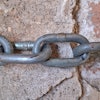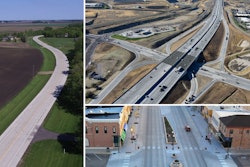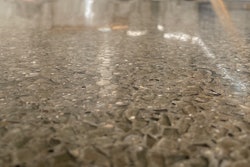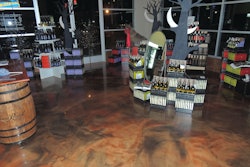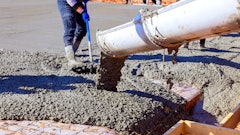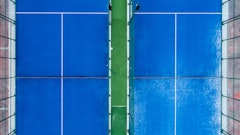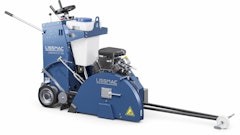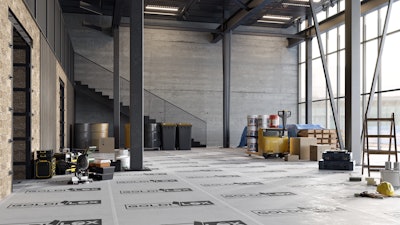
For 20 years business partners David Harris and David Forren have attended preconstruction meetings, and for 20 years, as the building team got to the specs for polished concrete—which architects and owners love, but general contractors hate to deal with—he could all but write script.
Harris and Forren are managing partners of Riverbed Concrete, a two-decade stalwart of concrete flooring, and Slick Rock Concrete, manufacturers of precast site furnishings, fire tables, fire bowls, and water bowls. They are also most recently the inventors and managing partners of a new products company called Goldilox, the peelable concrete floor protection about to turn the building world on its head.
“The GC is put in an impossible situation when polished concrete is specified,” Harris says. “The concrete slab is poured on day one. By the end of the project, that same surface has to be immaculate, on time, on budget—but with no sure way to protect it through the many months of heavy construction.” GoldiLox tackles this problem head-on.
Chicken Before the Egg
Wait a minute, you say. Doesn’t polishing protect the floor? Why not just polish before walls go up and let the densified concrete bear the brunt of the construction abuse.
Common misconception, Harris says. And a costly one. “For 20 years at meetings we’d educate everyone on what polished concrete is and is not,” he begins. “It’s wear tolerant. It’s durable—no recoating necessary. No stripping. No rewaxing or buffing. With commercial traffic it stays looking great. But construction abuse is not normal traffic. Polished or unpolished, concrete exposed to oil leaks, oversized construction machinery, metal shavings, dropped tools, chemical spills, and industrial mishaps will absorb stains and show construction abuse in the final product.”
So simple, you say. Just wait to polish the floors when the construction ends to remove construction damage. Harris shakes his head. Polished concrete should not be looked upon as a magic eraser to remove construction abuse. It just doesn’t work that way. Additionally, by the time the walls are up. The electricians, plumbers, painters, drywall, and other tradespeople make the worksite dangerous and difficult to coordinate around the industrial process of grinding and polishing, resulting in hugely inefficient installation and often sub-par results.
To further complicate the argument for polishing after walls, “OSHA recently classified silica dust similar to asbestos,” the 20-year concrete veteran adds. “So many installers are choosing to grind wet. Grinding wet alleviates dust concerns, but grinding wet after walls, with the other trades on site, invites mayhem. “You’re trying to run an industrial process around walls, through every door jamb and opening,” Harris says. “If it’s a new school building, for instance, you’re talking in and out of 100s of classrooms. The process becomes slow and broken.”
For a GC with an eye on budgets, installation quality, deadlines, as well as safety, the ideal is to polish early, uniformly, in an open field of concrete and then frame on top of it. No edging by hand needed, no more hand grinding those last inches near the wall (which never matches the field of the concrete). Fewer inconsistencies in clarity, shine, and uniformity while gaining significant improvements to production rates.
Traditional Ineffective Protection
For protection, some contractors in the first months will use OSB (oriented strand board) or plywood, with all the usual plywood problems. “It curls and bows in rain and trips people up,” Harris says. “Leaving it on the slab can often produce ghosting in the finished flooring. The open seams allow in oil and acidic spills. And the cost of sheet goods right now is through the roof.”
Since it's lightweight and inexpensive, wouldn't cardboard offer enough of a barrier to protect the polished floors? Harris doesn't believe so. Especially for the first months of heavy construction, before dry-in, cardboard is useless. “Cardboard is a non-starter, as soon as you pour, the cranes, lifts, big equipment, and abusive trades are there,” Harris explains. “You can’t tape cardboard to the concrete. It has seams and doesn’t stay down, so dust, metal shavings, dirt, and oil slip in. It turns to mush when wet. The earliest cardboard can go down is after the roof, doors, and windows are up—often months after work begins, and by then the contractor has missed the critical stages of protecting against heavy construction.”
He's also found rolls and sheets of plastic ineffective, explaining that "plastic almost always results in ghosting. It’s not seamless, meaning debris and liquids can easily get under it. On top of that, a slip-and-trip hazard."
For 20 years, by the end of a pre-con, the GC and Harris would lock eyes, one looking pained, the other resigned. “With the budget I’ve got, how the heck do I make sure the concrete I pour next week will look good when I turn the building over to the owner?” the GC would say.
For 20 years, the industry’s best answer has been a shrug.
 GoldiLox LLC | Photo by Jason Risner of Jason Risner Photography
GoldiLox LLC | Photo by Jason Risner of Jason Risner Photography
Results
 GoldiLox LLC | Photo by Jason Risner of Jason Risner Photography
GoldiLox LLC | Photo by Jason Risner of Jason Risner Photography
This got the Riverbed team thinking. “If we could develop an effective, budget-friendly form of protection we could dramatically improve our polishing production, become more competitive not only in cost but by delivering dependable results that our polishing competitors can't touch, ultimately landing more jobs per year.” It’s a win for the polishing sub, the GC, the architect, and the owner.
With this in mind, Harris and Forren began experimenting with options and adhesives to create a temporary protective covering. The team pressed in and finally found it: the magic combination of non-staining, temporary adhesive and woven industrial textile, creating a durable composite covering that is effective, and easy on budgets.
 GoldiLox LLC | Photo by Jason Risner of Jason Risner Photography
GoldiLox LLC | Photo by Jason Risner of Jason Risner Photography
“Our aim from the beginning was to create a protective covering that could be used industry-wide and on budget for the vast majority of subs and GCs at nearly half the price of other glue-down protection alternatives," Harris says. The patent-pending invention officially became GoldiLox, the “just right” solution offering the concrete polisher and GC to affordably deliver a final polished concrete floor that meets the expectations of the owners and architects, with fewer construction damages—affordably.
Looking to help the polishing industry, it was developed to address a missing link in the polishing process. Over the years the team behind GoldiLox hosted a lot of American Institute of Architect presentations for architect CE credits and discovered that architects are getting fed up, with specifying polished concrete only to be delivered a shiny floor that's riddled with stains by the end of the job.  GoldiLox LLC | Photo by Jason Risner of Jason Risner Photography
GoldiLox LLC | Photo by Jason Risner of Jason Risner Photography
“The goblins seem to come out overnight, especially with things like hydraulic oil,” he says from experience. “No GC can keep tabs on all of it 24/7. Lines bust. We’ve walked into jobs in the morning with a 10- by 10-ft.’ oil spill, and that’s the new reality of the finished flooring. Batteries blow up and etch into concrete. Buckets leak. In commercial buildings a big problem is metal piping for fire-prevention systems’ sprinkler lines, oily and full of rusty water. They get cut directly on the slab. Plywood and cardboard are useless to protect against so many of the damages subjected to the concrete during construction but are often the only materials the contractor can afford.”
Affordable, weather resistant, seamless, durable—it temporarily adheres onto the concrete surface like a second skin. Let workers walk on it and builders build on it. GoldiLox is antimicrobial and antifungal so erect the walls directly on top of it and leave under the framing. Pop lines directly on the white surface. Let cans of liquids topple on the protection and machines roll over it. Let dust, dirt and shavings blow across it. It is flame resistant so welders can work on it. GoldiLox is seamless and NFSI rated as high traction, so rest assured it’s safe to work on. With little to no maintenance, the protection system is the pro-GC and pro-budget.
 GoldiLox LLC | Photo by Jason Risner of Jason Risner Photography
GoldiLox LLC | Photo by Jason Risner of Jason Risner Photography
The meaning behind Goldilox name becomes clear. If you consider cheap and ineffective to be “too cold,” and overengineered and overly expensive to be “too hot,” Goldilox gets it right. Engineered by polish contractors for polish contractors, GoldiLox protects floors and schedules, reputations, and owners—adding utility into budgets so that architects continue to specify polished concrete with the assurance of a quality final product.
“Now what you see at the beginning is what you get at the end,” Harris says. “In most projects, GCs are walking on eggshells,” he says, “trying their darndest to have a quality floor by opening day. Now they don’t have to worry about it.
Protecting the concrete slab can turn from one of the biggest points of pain into one of the biggest points of pride—providing a “just right” solution to serve the polishing industry.


